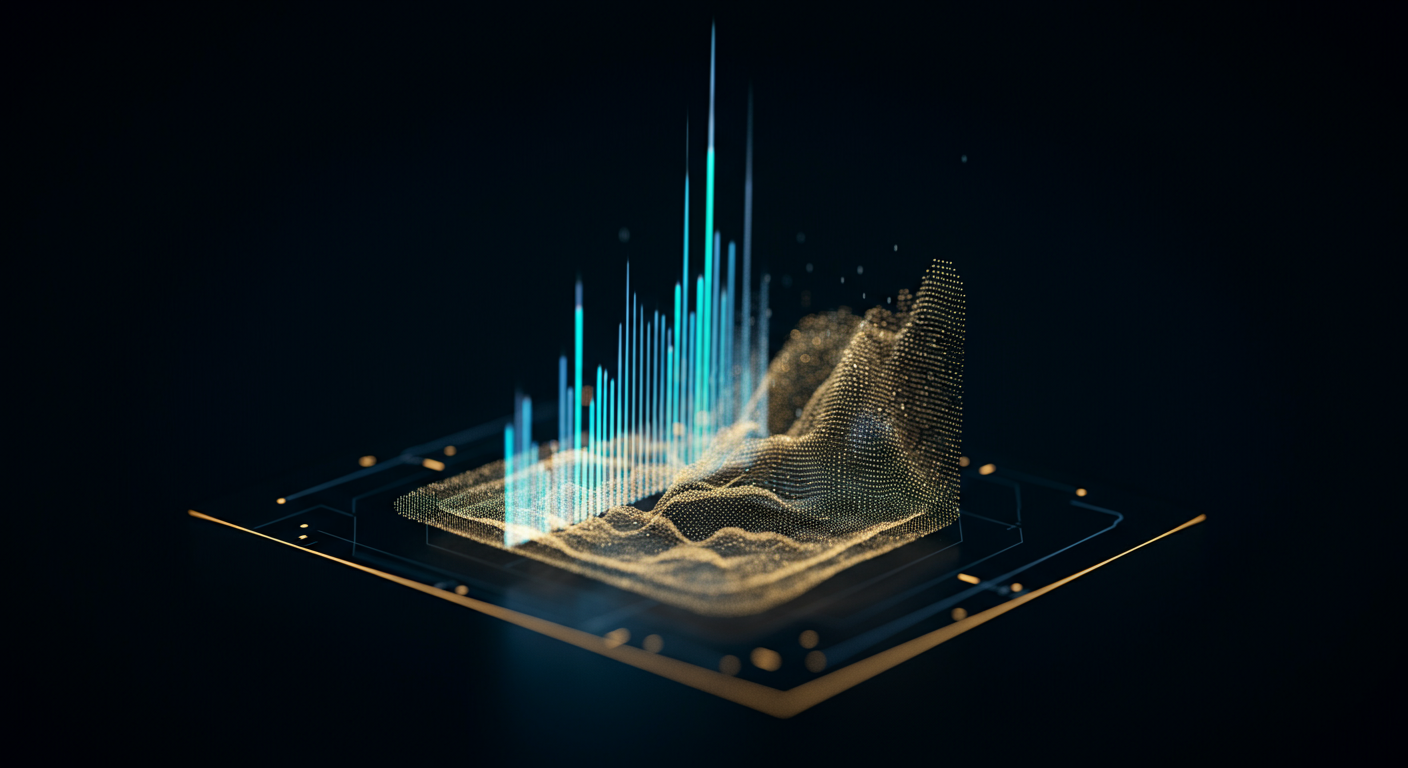DeepMind's WeatherNext: Unveiling the Future of Hyper-Fast Weather Prediction with Functional Generative Networks

Introduction: A Quantum Leap in Weather Forecasting
As sectors like agriculture, disaster management, and energy become increasingly reliant on accurate and timely weather insights, a revolutionary approach to weather prediction is not just welcome, but essential.
Enter DeepMind's WeatherNext, a groundbreaking AI model poised to redefine probabilistic weather forecasting. By leveraging Functional Generative Networks (FGNs), WeatherNext delivers forecasts up to 8x faster than traditional methods, offering a quantum leap in our ability to anticipate and prepare for weather events.
Functional Generative Networks (FGNs)
Functional Generative Networks (FGNs) are the engine driving WeatherNext's speed and accuracy.- These networks learn directly from raw weather data.
- FGNs generate probabilistic forecasts, providing a range of potential weather outcomes, offering a richer understanding of uncertainty compared to single-point predictions.
The Impact of Speed and Probability
The 8x speed improvement, coupled with probabilistic forecasting, could significantly impact various sectors.- Agriculture: Farmers can make more informed decisions about planting and harvesting.
- Disaster Management: Emergency responders can prepare more effectively for extreme weather events.
- Energy: Energy companies can better manage renewable energy sources.
Weather prediction, once a realm of educated guesses, is becoming increasingly precise thanks to AI.
Understanding Functional Generative Networks (FGNs): The Engine Behind WeatherNext
DeepMind's WeatherNext leverages Functional Generative Networks (FGNs), a cutting-edge AI architecture, for hyper-fast weather prediction. But what exactly are FGNs?
FGNs vs. Traditional Neural Networks
Think of traditional neural networks as static maps. FGNs, on the other hand, are dynamic functions that generate new functions.
Unlike standard Neural Networks, FGNs don't just learn a specific mapping from input to output; they learn a function that can generate an infinite number of mappings.
Modeling Spatiotemporal Data
- Traditional neural networks struggle with the complexities of spatiotemporal data, like weather patterns. FGNs excel because they can:
- Model dependencies across both space and time more effectively
- Learn complex functions that map historical weather data to future forecasts.
- This makes FGNs particularly well-suited for weather forecasting.
Functional Representation and Efficient Scaling

- Instead of dealing with massive datasets directly, FGNs learn to represent the underlying functions that govern weather patterns.
- This functional representation has several advantages:
- Faster computations: Representing data as a function allows for quicker calculations.
- Efficient Scaling: FGNs can efficiently scale to handle the vast amounts of data required for accurate weather forecasting.
WeatherNext: 8x Faster Probabilistic Weather Forecasts – A Deep Dive
DeepMind's WeatherNext aims to revolutionize weather forecasting, promising a glimpse into the future, faster than ever before. But what exactly does this entail, and why should professionals care?
WeatherNext Performance
WeatherNext achieves a staggering 8x speed improvement over traditional numerical weather prediction (NWP) models. This isn't just about shaving off minutes; it's about enabling truly real-time weather-dependent applications.
Think of drone delivery services optimizing routes on the fly or emergency responders getting immediate updates during a natural disaster.
Probabilistic Weather Models
Instead of a single, deterministic forecast, WeatherNext generates probabilistic forecasts. This means it provides a range of possible weather scenarios along with their probabilities.
- Example: Instead of saying "it will rain," it might say, "there's a 60% chance of rain, with potential rainfall ranging from 0.1 to 0.5 inches."
Weather Variable Predictions
WeatherNext is designed to predict a variety of critical weather variables. These can include:
- Temperature
- Precipitation
- Wind speed
- And potentially other relevant factors.
Areas for Improvement
While revolutionary, there are limitations. It's essential to understand that DeepMind weather AI is constantly evolving and there will always be room to improve its weather prediction accuracy.
In summary, WeatherNext offers a significant leap forward in speed and detail compared to traditional deterministic weather models. As AI continues to evolve, we can anticipate even greater precision and actionable insights from real-time weather forecasting.
Here's how AI-powered weather prediction is poised to revolutionize industries and society.
Agriculture: From Guesswork to Precision
Traditional farming relies heavily on historical data and educated guesses, but WeatherNext can take things to a whole new level by optimizing planting, irrigation, and harvesting schedules.- Optimized Irrigation: AI can analyze weather patterns to predict rainfall, helping farmers determine when and how much to irrigate, saving water and resources.
- Strategic Planting: Predicting optimal planting times based on long-term weather forecasts can maximize crop yields.
- Predictive Harvesting: Accurately predicting harvest windows allows for efficient labor allocation and minimizes crop loss due to unexpected weather.
Renewable Energy: Harnessing the Power of Prediction
Solar and wind energy generation are inherently dependent on weather conditions. Improved forecasting unlocks greater efficiency.- Optimized Energy Dispatch: Knowing when solar panels will be most productive or when wind speeds will peak allows grid operators to efficiently dispatch energy, reducing reliance on fossil fuels.
- Predictive Maintenance: Weather-related stress can damage renewable energy infrastructure. AI can predict potential risks, enabling proactive maintenance.
Disaster Management: Preparedness is Paramount
Accurate weather predictions are critical for effective disaster preparedness.- Early Warnings: Timely and precise forecasts of extreme weather events enable communities to prepare and evacuate, minimizing loss of life and property.
- Resource Allocation: Predictive models allow for the strategic allocation of emergency resources, ensuring help reaches those who need it most.
Aviation and Logistics: Optimizing Routes and Minimizing Disruptions
From flight paths to delivery routes, weather plays a crucial role in transportation.- Optimized Flight Routes: AI can analyze weather patterns to identify optimal flight paths, reducing fuel consumption and improving safety.
- Efficient Logistics: By predicting weather-related disruptions, logistics companies can optimize delivery routes and minimize delays.
Here's how WeatherNext stacks up against the old guard of weather prediction.
WeatherNext vs. Numerical Weather Prediction (NWP)

Traditional Numerical Weather Prediction (NWP) models have long been the cornerstone of forecasting, but WeatherNext represents a paradigm shift; as an AI-driven model developed by DeepMind, it leverages functional generative networks to deliver hyper-fast weather predictions.
Think of NWP as meticulously solving complex equations, while WeatherNext learns patterns directly from data.
- Accuracy: NWP models are known for their reliable accuracy, honed by decades of refinement. WeatherNext strives to match or exceed this accuracy, but its performance can be more sensitive to the quality and quantity of training data.
- Speed: WeatherNext shines with its rapid processing. Traditional NWP models can be computationally intensive, requiring significant time for simulations, whereas WeatherNext offers near-instantaneous forecasts, potentially opening doors for real-time decision-making.
- Computational Cost: The training of WeatherNext might be resource-intensive initially, but inference is significantly cheaper than running complex NWP simulations.
Strengths and Weaknesses
Here's a quick rundown:
| Feature | WeatherNext | Numerical Weather Prediction (NWP) |
|---|---|---|
| Accuracy | Data-dependent, evolving | Generally reliable |
| Speed | Hyper-fast | Slower, computationally intensive |
| Computational Cost | High initial training cost, low inference | High ongoing cost |
| Data Needs | Requires extensive historical data | Relies on physical equations & data |
Complement or Replace?
WeatherNext isn't necessarily about outright replacement. More realistically, it could augment existing NWP models, providing quick, high-resolution forecasts for specific applications. It could also fill gaps where computational resources are limited.
Open-source weather data, like that from the National Oceanic and Atmospheric Administration (NOAA), is crucial for both NWP and AI-based models, empowering researchers and developers to improve forecasting accuracy.
In conclusion, WeatherNext brings a new dimension to weather forecasting by prioritizing speed and efficiency, marking a significant advancement in AI's practical applications. As AI continues to evolve, expect even more sophisticated tools to emerge on platforms like Best AI Tools.
The Future of Weather Prediction: What's Next for DeepMind and AI?
DeepMind's WeatherNext has demonstrated that AI can revolutionize weather forecasting, and the possibilities for the future are expansive.
Expanding WeatherNext Capabilities
DeepMind is likely exploring ways to refine WeatherNext's accuracy and extend its forecasting range. We can expect research to focus on:- Higher Resolution: Refining the model to predict weather patterns with greater precision at a localized level.
- Longer Time Horizons: Extending the forecast window from days to weeks or even months ahead.
- Integration with Other Data Sources: Incorporating climate data, geological information, and other environmental factors.
AI Synergies: Reinforcement Learning and Computer Vision
Combining WeatherNext with other AI techniques holds immense potential.
- Reinforcement Learning: Training AI agents to optimize resource allocation based on weather predictions, such as energy grid management. For example, AI in 2025: Cybersecurity Copilots, Open-Source Science, and the $250M Talent War – Daily News 18 Aug 2025 highlights the increasing importance of AI in resource optimization.
- Computer Vision: Analyzing satellite imagery and radar data with computer vision algorithms to enhance the accuracy of weather predictions.
Ethical Considerations
The use of AI in weather forecasting raises critical ethical questions:- Data Privacy: Ensuring the responsible collection and use of weather data.
- Algorithmic Bias: Mitigating potential biases in AI models to ensure fair and equitable weather predictions. See, for example, AI Bias Detection: A Practical Guide to Building Fair and Ethical AI.
Long-Term Impact
Looking ahead, AI will play a pivotal role in addressing climate change through:- Improved Climate Modeling: Enhancing the accuracy of climate models to better understand and predict the long-term effects of climate change.
- Climate Change Mitigation: Contributing to the development of strategies for mitigating climate change, such as renewable energy optimization and carbon capture.
Navigating the complex world of weather forecasting just got easier, thanks to the democratization of AI.
Publicly Available Weather APIs and Datasets
Ready to get hands-on with AI and weather? Several APIs offer access to real-time and historical weather data. Consider these options:- OpenWeatherMap: Provides various APIs for current weather data, forecasts, and historical information.
- AccuWeather API: Offers detailed weather data, including minute-by-minute forecasts.
- NOAA (National Oceanic and Atmospheric Administration): Provides extensive datasets, including weather models and observations.
Libraries for Weather Data Processing and AI Model Development
Harness the power of AI with these user-friendly libraries:
- TensorFlow: Google's open-source machine learning framework is excellent for building and training complex weather models. See TensorFlow for a simple intro to the tool.
- PyTorch: Another popular framework favored for its flexibility and dynamic computation graphs.
AI Weather Forecasting Tutorial and Learning Resources
Looking to dive deeper? Consider these resources:
- Online Courses: Platforms like Coursera and edX offer courses on machine learning and AI, with specific modules on time-series forecasting (critical for weather).
- Tutorials: Websites like Kaggle host tutorials and datasets for weather forecasting, allowing you to learn from real-world examples.
- AI Fundamentals: A great place to start if you are new to AI.
Training and Certification
Formalize your knowledge with these training and certification options:
- AWS Certified Machine Learning – Specialty: Validates your expertise in building, training, and deploying ML models using Amazon Web Services.
- Google Cloud Professional Machine Learning Engineer: Showcases your ability to design and build ML solutions using Google Cloud technologies.
AI weather tools are no longer a distant dream; they're a tangible reality. By exploring available APIs, leveraging powerful libraries, and investing in education, you can be at the forefront of this exciting field.
DeepMind's WeatherNext is demonstrating the transformative potential of AI, offering lightning-fast weather predictions with unprecedented accuracy.
Harnessing the Power of AI for Forecasting
- Speed and Efficiency: WeatherNext leverages functional generative networks to drastically reduce forecasting time.
- Transformative Impact: The impact of AI on weather prediction extends to agriculture, disaster management, and energy. This advancement helps optimize resource allocation and improve preparedness.
Explore the Opportunities
- Dive Deeper: Explore resources at Learn to understand the underlying technologies behind AI weather prediction.
- Industry Impact: Consider the implications of AI weather prediction future on your field.
- Tool Discovery: Use our tools directory to find the best AI solutions for your specific needs.
The Future is Here
The convergence of AI and weather forecasting is more than just an academic exercise; it's a practical revolution. We encourage you to share your experiences and thoughts on how AI-powered weather forecasting is changing our world. Join the conversation and help shape the future of this rapidly evolving field.
Keywords
DeepMind WeatherNext, Weather forecasting, Functional Generative Networks, AI weather prediction, Probabilistic forecasting, Hyper-fast weather forecasts, Weather prediction accuracy, AI in agriculture, Disaster management AI, Real-time weather forecasting, FGN architecture, AI and climate change, Weather APIs, Weather datasets
Hashtags
#AIWeather #DeepMind #WeatherTech #Forecasting #ArtificialIntelligence
Recommended AI tools

Your AI assistant for conversation, research, and productivity—now with apps and advanced voice features.

Bring your ideas to life: create realistic videos from text, images, or video with AI-powered Sora.

Your everyday Google AI assistant for creativity, research, and productivity

Accurate answers, powered by AI.

Open-weight, efficient AI models for advanced reasoning and research.

Generate on-brand AI images from text, sketches, or photos—fast, realistic, and ready for commercial use.
About the Author

Written by
Dr. William Bobos
Dr. William Bobos (known as 'Dr. Bob') is a long-time AI expert focused on practical evaluations of AI tools and frameworks. He frequently tests new releases, reads academic papers, and tracks industry news to translate breakthroughs into real-world use. At Best AI Tools, he curates clear, actionable insights for builders, researchers, and decision-makers.
More from Dr.

